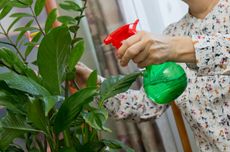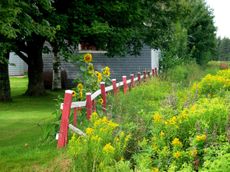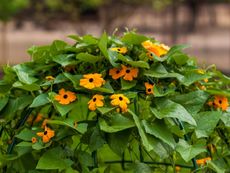Problems
If only things could always go right in the garden. The fact of the matter is, sometimes they don't. Pests, disease, environmental hazards and more can strike your plants. Learn what they are and how to prevent them here.
Explore Problems
Editor's Picks
Problems
-

Reasons For Early Leaf Drop: Why Are My Plants Losing Leaves
The reasons for unexpected leaf drop can be weather-related. Learn more about early leaf drop in trees and plants and how it can be weather-related here.
By Teo Spengler
-

Flower Drop Tips: Reasons Why Healthy Blooms Fall Off
If you've ever experienced the disappointment of having healthy buds and flowers drop off of your plants, this article is for you. Click here to find out what causes blossom drop in plants, and what you can do about it.
By Jackie Carroll
-

Larvicide Treatment Tips: How And When To Use Larvicide
There are many ways to deal with pests in the yard or garden. If you have standing water, larvicides can be a good option in addition to preventative practices. Know the pros and cons before you use larvicides in your garden. Click here to learn more.
By Mary Ellen Ellis
-

What Is Milky Spore: Using Milky Spore For Lawns And Gardens
Japanese beetle larvae feed on grass roots, leaving ugly, brown dead spots in the lawn. However, they are susceptible to several biological controls, including milky spore disease. Learn more about this here.
By Jackie Carroll
-

What Are Leaf Footed Bugs: Learn About Leaf Footed Bug Damage
Although many of the bugs in the garden can be easily distinguished as friend or foe, the leaf footed bug is not among them. These sometimes problematic insects require careful observation so you can clearly say if they're harming your garden plants. Learn more here.
By Kristi Waterworth
-

Indoor Thrips Control – Getting Rid Of Thrips On Houseplants
Thrips indoors are not as common as thrips on outdoor plants, but they do occur and it is important to take care of them before the damage becomes too difficult to deal with. It is best to identify them early in order to have the best chance in getting rid of them. Learn more here.
By Raffaele Di Lallo
-

INSV Information - Plants Affected By Impatiens Necrotic Spot Virus
There are a lot of things that can happen to your plants between the moment they emerge from their seeds until they fruit or bloom, wilt and die. Of all the things that can go wrong, INSV may be one of the most challenging. Find out more about this disease here.
By Kristi Waterworth
-

Invasive Native Plants – Can Native Plants Become Invasive
Not all exotic and non-native plants are invasive, and not all native plants are strictly non-invasive. It can be confusing, but even native plants can grow in such a way that they become problematic and invasive. Learn more about this here.
By Mary Ellen Ellis
-

Controlling Squash Bugs - How To Get Rid Of Squash Bugs
Squash bugs are one of the most common pests affecting squash plants, but also attack other cucurbits as well. Squash bug identification is relatively easy to recognize with tips from this article.
By Nikki Tilley
-

Controlling Predatory Birds: What To Do For Birds Of Prey In My Garden
If you enjoy watching wildlife in your garden, for some of you, one animal you don't want to see is a bird of prey. Find out how to discourage hawks and owls from visiting your garden in this article should they be a threat to your peace of mind.
By Jackie Carroll
-

Managing Henbanes – Black Henbane Weed Info And Growing Conditions
What is henbane? Henbane was introduced to North America from Europe. It has escaped cultivation since that time and is now found across most of the United States. Click here to learn more about this plant and its control.
By Mary H. Dyer
-

Hairy Galinsoga Control: Tips For Controlling Shaggy Soldier Weeds
Shaggy soldier weed plants are serious weed pests in many areas. Also known as Galinsoga weeds, they can reduce yield by up to half in row crops. Use the facts from this article so you can safely and successfully combat this tenacious weed.
By Bonnie L. Grant
-

Coral Spot Fungus Information – What Are Signs Of Coral Spot Fungus
What is coral spot fungus? This damaging fungal infection attacks woody plants and causes the branches to die back. Here's what you need to know about the disease, what you can do to prevent it, and how to spot it on your trees and shrubs. Click here to learn more.
By Mary Ellen Ellis
-

Hairy Bittercress Killer: Learn More About Control For Hairy Bittercress
Late winter and spring signal growth of all plants but especially weeds, like hairy bittercress weed. What is hairy bittercress? This article explains more as well as how to keep the weed under control.
By Bonnie L. Grant
-

Is Hairy Bittercress Edible – Learn How To Use Hairy Bittercress Weeds
What you may not realize as you’re hoeing or pulling weeds, is that although it may look like just another stubborn invader, hairy bittercress actually has a pungent, peppery flavor and many uses in the kitchen. The entire plant is edible. Click here to learn more.
By Mary H. Dyer
-

Greater Celandine Plant Info: Information About Celandine In Gardens
Greater celandine is an interesting, attractive flower known by several alternate names. Click on this article for greater celandine plant info, including concerns about greater celandine in gardens. Learn more here.
By Mary H. Dyer
-

Giant Hogweed Information – Tips For Controlling Giant Hogweed Plants
Giant hogweed is one scary plant. What is giant hogweed? It is a Class A noxious weed and is on several quarantine lists. Learn more about its control and where it grows in this article. Click here for additional information.
By Bonnie L. Grant





